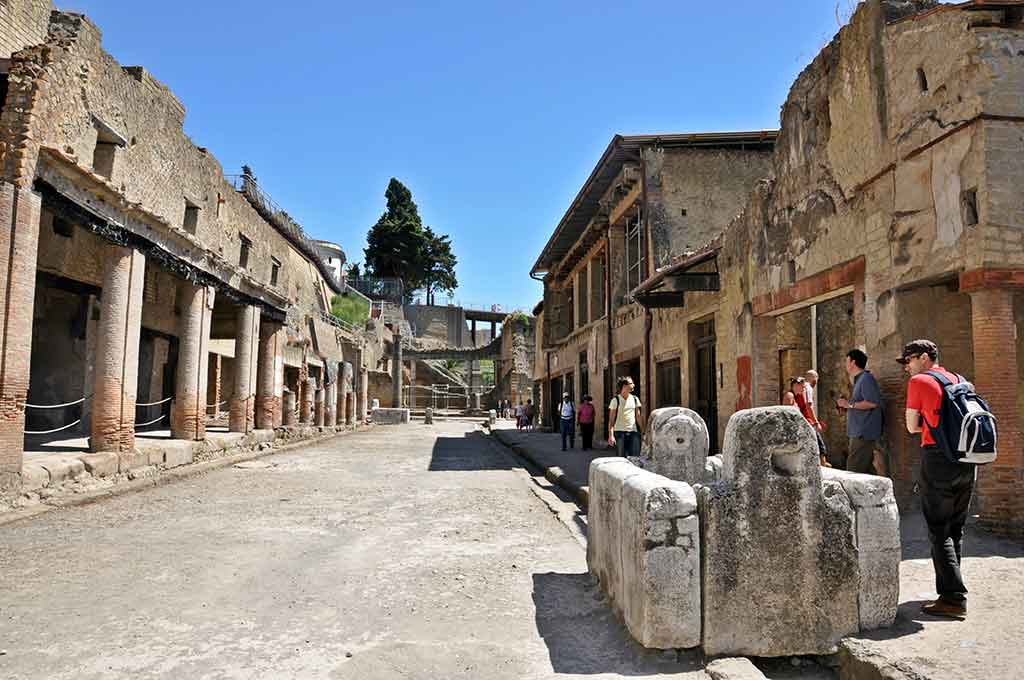
Archaeological Park of Herculaneum
Brief History of Ercolano
This is a town and a municipality situated in the region of Naples at the southern part of Italy, Campania. The town lies at Mount Vesuvius western foot on the bay of Naples at the southeast part of the city of Naples. The ancient town was built the remnants of a volcanic eruption of Vesuvius which destroyed Herculaneum, an ancient city from which Ercolano name is derived.
The town is believed to have been found by an Italic tribe called Oscans around 8th century BC later becoming a dominion of Samnite and Etruscan. The city become a renowned tourist resort while under the Roman control which saw some of the richest Roman citizens pass their summer vocations in this town.
Herculaneum had previously suffered serious damage from an earthquake in AD 63 but had the bigger hit by the most famous eruption in world history when Vesuvius blew its lid with its eruption burying Herculaneum in a tidal wave of molten mud which enveloped the city with up to 82 feet of burning mud, rocks and sand. It is said most of its citizen died out of thermal shock from the hot pyroclastic surges rather than being buried under the ash like the neighboring Pompeii town.
After this incidence the town was repopulated in the next 1000 years which consequently saw the creation of a small town Resina which was named after the ancient sanctuary. Homes and neighborhoods were built above the uncovered ancient ruins of Herculaneum, this development triggered rediscovering and exploration of this ancient city. Resina ultimately became part of the municipal area of the city of Naples after the unification of Italy in 1861who took it up from the Kingdom of the Two Sicilies. The town was later renamed from Resina to Ercolano in 1969 in a bid to revise the old name in honor of the primeval capital, Herculaneum.
Sights to visit in Ercolano
Ercolano has a relatively small archeological site as compared to that of Pompei but the house that were excavated after the eruption are still intact with many still preserving their floor mosaics and their second stories, wall frescoes, wooden furnishings, ceiling stuccoes amongst other decors.
The following are a number of these houses which have come to be tourist attractions in Ercolano:
The Baths also known as Thermae
Although in ruins, these remains are still in pretty good shape and a visit to them will give you an idea of how a typical ancient Roman citizen experience at these baths. After tiring exercises at the fitness center (palestra) one would continue to either the men’s or women’s section dipping first in the hot tub known as calidarium before entering the tub full of warm water and finally jumping to the frigidarium, a cold pool meant to close the pores. Some of the stuccoes and the domed ceilings still exist.
House of bicentenary
This house excavation was finished in 1938 two hundred years after the official digging had started hence named bicentenary. This house is decorated with frescoes and a cross that probably could be the oldest artifact testifying Christianity in Roman Empire.
Casa sannitica
This house has an arrangement that was distinctive of the Samnites, an ancient community that lived in this mountainous part. The remains of the casa Sannitica has its rooms decorated with frescoes with this impressive atrium that is kilted by gallery with lonic columns.
The House of the Mosaic Atrium
This is surrounded with surging checkerboard medley on the atrium floor with mythological scenes frescoed in room that overlook the garden.
Casa dei Cervi (house stags)
This is a rich patrician mansion which probably is one of the most beautiful houses overlooking the Bay. The house is well decorated with numerous frescoes and artworks including a marvelous sculptured group of stags being attacked by dogs.
Pistrinum (bakers)
An inscription on this building states that the bakery belonged to one Sextus Patulus Felix. A large oven and mills can be seen at the backyard of the baker’s.
Theater
The theatre which is placed at the edge of the archeological site is believed to have been accommodating an approximated two thousand spectators.
Casa a Graticcio
This house derives its name from the wooden trellis which formed the graticcio (framework) of its walls. This house is the only antique example of this technique of construction.
Casa del Mosaico di Nettuno e Anfitrite
This is another archeological site of a house equipped with a shop having its counter facing to the street. The nymphaeum is decorated by mosaics that depict Amphitrite and Neptune.
Discover the surrounding of Ercolano